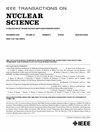High-Resolution Metal-Oxide-4H-SiC Radiation Detectors: A Review
IF 1.9
3区 工程技术
Q3 ENGINEERING, ELECTRICAL & ELECTRONIC
引用次数: 0
Abstract
This article reviews the performance of vertical metal-oxide-semiconductor (MOS) radiation detectors on n-type 4H-silicon carbide (SiC) epitaxial layers, comparing SiO2, Y2O3, and Ga2O3 oxide layers. While the fabrication of conventional Schottky barrier detectors (SBDs) is much simpler, MOS detectors allow higher bias voltages, achieving full depletion in thick epitaxial layers. Fully depleted thick epitaxial layers pose larger attenuation to penetrating radiation such as X-/高分辨率金属氧化物-4H-SiC 辐射探测器:综述
本文回顾了在 n 型 4H 碳化硅(SiC)外延层上的垂直金属氧化物半导体(MOS)辐射探测器的性能,并对 SiO2、Y2O3 和 Ga2O3 氧化物层进行了比较。虽然传统肖特基势垒探测器(SBD)的制造要简单得多,但 MOS 探测器允许更高的偏置电压,从而实现厚外延层的完全耗尽。完全耗尽的厚外延层对 X 射线/伽马射线和中子等穿透性辐射的衰减更大,从而实现了高效和高分辨率的探测。因此,基于 4H-SiC 的 MOS 探测器直接满足了开发适用于核反应堆堆芯和太空任务等恶劣环境中穿透辐射的硬辐射探测器的需求。本研究中讨论的所有 MOS 探测器都具有出色的整流特性,其中 Y2O3 MOS 探测器的反向偏压漏电流最低。Y2O3 MOS 探测器在自偏压模式下也显示出最高的分辨率和电荷收集效率(CCE),即使与基准 Ni/4H-SiC SBD 相比也是如此。对于 5486 千兆赫的阿尔法粒子,所有 MOS 探测器在优化偏压下都显示出很高的能量分辨率。基准 SBD 0.29% 的能量分辨率是由于 4H-SiC 外延层中的 Z $_{1/2}$ 和 EH $_{6/7}$ 陷阱浓度大大低于 MOS 探测器中的浓度。这项研究强调了抑制 Z $_{1/2}$ 和 EH $_{6/7}$ 等寿命杀手陷阱中心以提高探测器性能的重要性,并强调了进一步研究表面钝化机制及其对结点特性影响的必要性。
本文章由计算机程序翻译,如有差异,请以英文原文为准。
求助全文
约1分钟内获得全文
求助全文
来源期刊

IEEE Transactions on Nuclear Science
工程技术-工程:电子与电气
CiteScore
3.70
自引率
27.80%
发文量
314
审稿时长
6.2 months
期刊介绍:
The IEEE Transactions on Nuclear Science is a publication of the IEEE Nuclear and Plasma Sciences Society. It is viewed as the primary source of technical information in many of the areas it covers. As judged by JCR impact factor, TNS consistently ranks in the top five journals in the category of Nuclear Science & Technology. It has one of the higher immediacy indices, indicating that the information it publishes is viewed as timely, and has a relatively long citation half-life, indicating that the published information also is viewed as valuable for a number of years.
The IEEE Transactions on Nuclear Science is published bimonthly. Its scope includes all aspects of the theory and application of nuclear science and engineering. It focuses on instrumentation for the detection and measurement of ionizing radiation; particle accelerators and their controls; nuclear medicine and its application; effects of radiation on materials, components, and systems; reactor instrumentation and controls; and measurement of radiation in space.
 求助内容:
求助内容: 应助结果提醒方式:
应助结果提醒方式:


